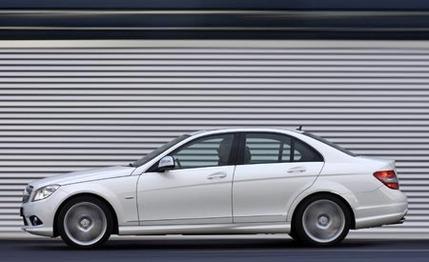
 First Drive Review
First Drive Review
Among automotive cognoscenti, the Mercedes C-class has long labored in the shadow of BMW's 3-series, a wistful also-ran in the entry luxury-sports-sedan sweepstakes.
To be fair, corporate wistfulness has been tempered by frequent bank deposits. Over the course of its long history—Mercedes is celebrating the 25th anniversary of its entry-level sedan this year—the company has produced and sold some six million of them.
Which suggests the kids in Stuttgart were doing a pretty good job.
Be that as it may, with the introduction of the fourth generation C-class (W204), the long quest for sports-sedan equality may be over. Based on a short first drive in a C350 Sport, the smallest Mercedes sedan looks ready to challenge BMW's segment leadership on fairly equal footing.
Smallest is a relative term here. The baby Benz is smallest among Mercedes' four-door sedans, but it's bigger in every dimension than its predecessor, and also bigger than 3-series four-ports in length and height, riding on an identical 108.7-inch wheelbase.
Bigger translates to roomier, something rear-seat passengers are sure to appreciate.
But bigger also translates to increased mass. Mercedes worked hard to keep curb weights in check for the new car, but there appears to be some inevitable gain at the scales. Mercedes forecasts 3615 pounds for the C350 Sport under scrutiny here, which is 100 more than the C350 Sport we tested in the November 2005 issue of Car and Driver and heavier than either of the gasoline-powered 3-series sedans (328i, 335i) we see in the U.S. market.
That 2005 C350 sprinted to 60 mph in an impressive 5.5 seconds. The new C350 Sport is propelled by the same 3.5-liter DOHC 24-valve V-6 as its predecessor, with identical output (268 horsepower, 258 pound-feet of torque), mated to the same seven-speed automatic transmission.
All things being equal except for a slight increase in mass, it's hard to see the new C350 being quicker than the gen-three edition. Mercedes forecasts 6.6 seconds, which we view as conservative.
The governor-limited top speed is listed as 130 mph.
In any case, the C350 doesn't have the authority of a BMW 335i, with its 300-hp twin-turbo six. On the other hand, the Mercedes seven-speed automatic makes the most of the C350's power (although we could wish for quicker upshifts in paddle-shift manumatic mode), throttle response is instantaneous, and performance in dicey mountain-road passing maneuvers leaves little to be desired.
More important in this C-class push for sports-sedan parity, the C350's agility index, rooted in a chassis rated 16 percent stiffer, finally rivals that of a 3-series sedan when the asphalt gets kinky and the g-loads escalate. Although the suspension layout is essentially the same as the previous C350's, the system has firmer bushings, new subframes, and revised geometry augmented by new dampers that adapt to varying loads.